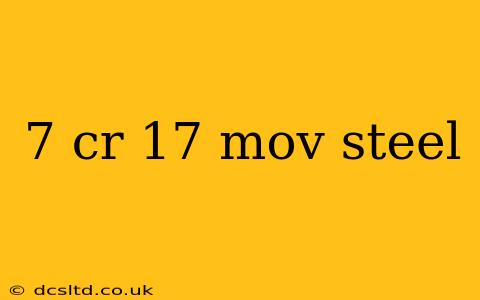Decoding 7Cr17MoV Steel: A Deep Dive into its Properties and Applications
7Cr17MoV steel, also sometimes referred to as 7Cr17, is a versatile stainless steel grade known for its excellent corrosion resistance and reasonable strength. Understanding its composition, properties, and applications is crucial for anyone working with this material, whether in manufacturing, engineering, or design. This comprehensive guide will delve into the intricacies of 7Cr17MoV steel, answering common questions and providing valuable insights.
What is 7Cr17MoV Steel?
7Cr17MoV steel is a martensitic stainless steel. This means it's a type of steel that contains chromium (Cr) as its primary alloying element, providing corrosion resistance. The "7" in the designation typically indicates approximately 7% chromium content. The addition of molybdenum (Mo) and vanadium (V) further enhances its properties. These alloying elements contribute to improved hardenability, strength, and corrosion resistance, particularly in more challenging environments.
What are the properties of 7Cr17MoV steel?
7Cr17MoV steel boasts a unique combination of properties making it suitable for a wide array of applications:
- High Corrosion Resistance: The chromium content provides excellent resistance to rust and corrosion, making it suitable for outdoor and damp environments.
- Good Strength: The addition of molybdenum and vanadium significantly improves the steel's strength and hardness, especially after heat treatment.
- High Hardenability: This allows for achieving higher hardness levels through heat treatment processes, contributing to its durability.
- Good Wear Resistance: Its hardness and strength contribute to decent wear resistance, suitable for components subjected to friction.
- Machinability: While not as readily machinable as some other steels, 7Cr17MoV is still considered machinable with appropriate tooling and techniques.
What are the common applications of 7Cr17MoV steel?
The versatile properties of 7Cr17MoV steel translate into a variety of applications:
- Cutlery: Its corrosion resistance and ability to hold a sharp edge make it a popular choice for knives and other cutlery items.
- Hand Tools: Its strength and wear resistance are beneficial for hand tools that require durability.
- Medical Instruments: The corrosion resistance is critical for instruments used in surgical procedures and medical devices.
- Automotive Parts: Certain automotive components benefit from its strength and corrosion resistance.
- Industrial Components: Various industrial applications leverage its properties in environments where both strength and corrosion resistance are needed.
How does 7Cr17MoV steel compare to other stainless steels?
7Cr17MoV steel distinguishes itself from austenitic stainless steels (like 304 and 316) by its higher strength and hardenability, but with slightly reduced corrosion resistance in certain aggressive environments. Compared to other martensitic grades, 7Cr17MoV often offers a balance of properties making it suitable for a wider range of applications. The specific choice depends greatly on the application's exact requirements.
What is the heat treatment process for 7Cr17MoV steel?
The heat treatment process for 7Cr17MoV steel is crucial for achieving its optimal properties. It typically involves austenitizing (heating to a high temperature), quenching (rapid cooling), and tempering (reheating to a lower temperature). This process significantly increases the hardness and strength of the steel. The specific parameters of the heat treatment will depend on the desired final properties.
What are the limitations of 7Cr17MoV steel?
While 7Cr17MoV steel offers many advantages, it also has some limitations:
- Weldability: Welding can be more challenging compared to some other stainless steel grades, requiring specialized techniques and expertise to avoid cracking or other defects.
- Formability: Its high strength can make it more difficult to form into complex shapes compared to more ductile steels.
- Cost: Compared to some lower-alloy steels, 7Cr17MoV can be more expensive due to its alloying composition.
This comprehensive overview provides a solid foundation for understanding 7Cr17MoV steel. Remember, always consult detailed specifications and material datasheets for accurate information relevant to your specific application. The information provided here is for general knowledge and should not be substituted for professional engineering advice.
